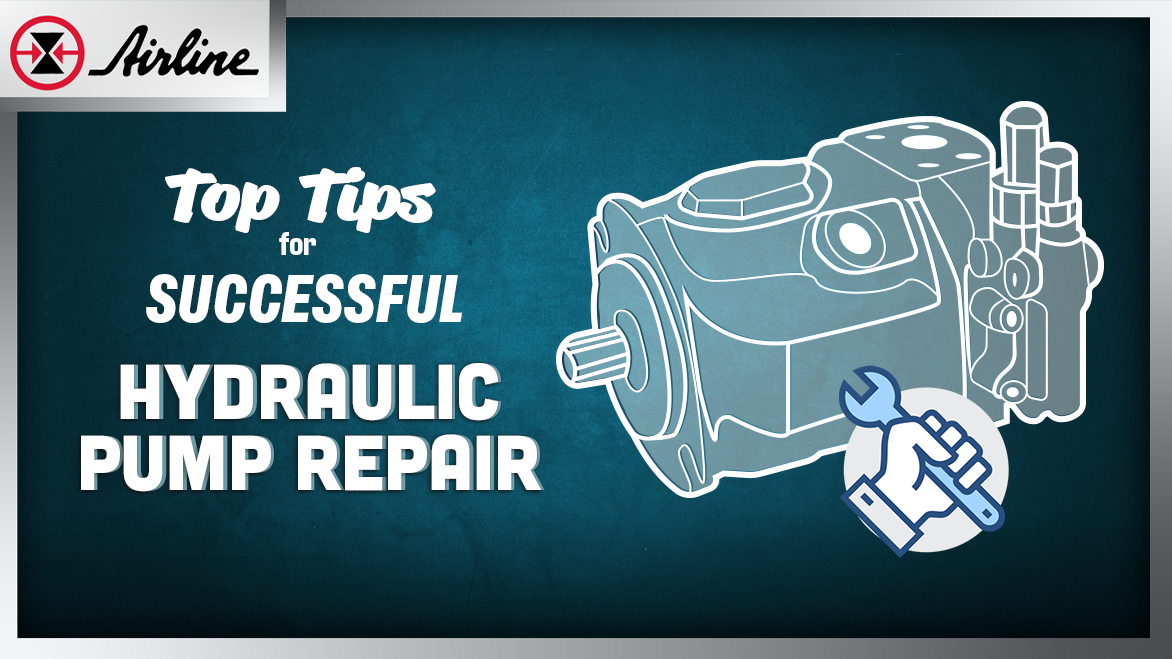Hydraulic pumps are the heart of your hydraulic system. But what happens when the heart stops? 😳 The entire hydraulic operation may come to a standstill. That's why understanding the basics of hydraulic pump repair is crucial. In this blog post, we'll walk you through common hydraulic pump issues and a systematic approach to hydraulic pump repair. Whether you're a maintenance technician or an industrial equipment owner, these tips will help you get back up and running as quickly as possible.
Skip to a Section
Understanding Hydraulic Pumps | Common Issues Leading to Hydraulic Pump Repair | Steps to Effectively Repair a Hydraulic Pump | Preventative Maintenance Tips | Choosing the Right Hydraulic Pump Repair Service | Frequently Asked Questions

Key TakeawaysUnderstanding the various types of hydraulic pumps—piston, vane, and gear pumps—can help in selecting the appropriate one for specific applications and in diagnosing issues effectively.
|
Understanding Hydraulic Pumps
Hydraulic pumps are the heart of any hydraulic system, converting mechanical energy into hydraulic energy by moving fluid through the system. Familiarizing yourself with the characteristic wearing issues for the different types of hydraulic pumps will help you diagnose any issues that arise. The most common types include piston pumps, vane pumps, and gear pumps. We’ll now examine these types more comprehensively.
The photo below shows where a hydraulic pump functions within a typical hydraulic circuit.
Gear Pumps
Gear Pumps tend to wear into their housings after experiencing many pressure cycles. If the gears and/or housing show wear, repair of a gear pump is typically not economical. If the gear pump leaks externally, but is otherwise functioning at a high rate of efficiency, resealing the unit may be an option.
Vane Pumps
Vane Pumps typically maintain their efficiency until they fail. A vane pump can be completely rebuilt by replacing the vane cartridge, shaft and bearing. Typically replacing the vane cartridge kit will suffice to return the pump to it’s original operational efficiency.
Piston Pumps
Piston pumps are among the most intricate pumps to repair, featuring numerous moving parts and wear surfaces that require thorough inspection and assessment for potential reuse or replacement. Airline's Pump Technicians utilize years of expertise to determine not only which parts need replacement but also what condition caused the damage in the first place. Airline only uses Bosch Rexroth parts on our pump repairs to ensure a factory-quality rebuild, each and every time.
Explore hydraulic pumps on airlinehyd.com
Common Issues Leading to Hydraulic Pump Repair
Hydraulic pumps often require repair due to common issues like wear, contamination, and excess pressure. By recognizing these issues, you can spot problems early and intervene before they escalate into more severe failures. Some of the most common issues include fluid contamination, cavitation, excessive temperature, and uncorrected leaks. Each of these problems can significantly impact the performance and longevity of your hydraulic pumps.
Some common causes of failing hydraulic pumps include:
Fluid contamination, where dirt, debris, and moisture impair the pump’s performance
Cavitation, which occurs when hydraulic fluid experiences low pressure, forming vapor bubbles that collapse rapidly and erode pump surfaces
Excessive temperature, which can exacerbate other issues such as fluid contamination and poor fluid viscosity
Uncorrected leaks can reduce pump performance and increase the potential for hydraulic pump failure over time.
We’ll now examine each of these internal components issues more thoroughly.
Fluid Contamination
Fluid contamination can severely impact the performance of a hydraulic pump. (Read: 6 Types of Fluid Contamination You Need to Know). Dirt, debris, and moisture can enter the system during oil changes or through inadequate seals, causing friction and wear. Built-in contamination can occur during the manufacturing process, where burrs or chips left from machining break loose and cause damage inside the pump.
To prevent hydraulic pump failure from fluid contamination, it’s vital to:
- Keep the hydraulic fluid clean
- Perform regular inspections
- Replace filters as needed
- Ensure the suction strainer is clean and functioning properly.
Read: Unlock the Secrets of Varnish Mitigation: Improve Your Hydraulic Systems Performance Now
Cavitation
Cavitation is a damaging condition that occurs when vapor bubbles form and collapse within the hydraulic pump, causing physical damage to components. This can be caused by air bubbles in the fluid or low fluid pressure and flow. Proper fluid levels and maintaining consistent fluid flow can help prevent cavitation.
Quickly dealing with cavitation can prevent substantial pump damage and maintain smooth operation.
Excessive Temperature
Excessive temperature can cause premature wear, fluid degradation, and seal failure in hydraulic pumps. Potential causes of overheating include:
- Low reservoir fluid levels
- Reservoir airflow obstructions
- Heat exchanger core blockage
- Internal leaks
- Cavitation
These factors can all contribute to the issue and should be carefully monitored. Operating a hydraulic pump at temperatures above 180 degrees Fahrenheit can reduce pump efficiency and cause component failure.
To avoid these problems, it’s important to keep track of and manage the system’s heat.
Uncorrected Leaks
Uncorrected leaks in a hydraulic pump can lead to significant performance issues and potential failure over time. Inadequate seals or internal component damage can cause leaks, reducing pump performance. Inspecting seals, gaskets, and fittings for wear and tear, and replacing them if necessary, is essential to prevent leaks.
Quickly handling hydraulic fluid leaks can prevent additional damage and keep the pump operating optimally.
Steps to Effectively Repair a Hydraulic Pump
To repair a hydraulic pump, you need a systematic approach and a basic understanding of its components. You also need a clean space free of any debris and tools like a socket wrench, seal puller, and torque wrench.
The pump repair process involves the following steps:
- Identify the Problem
- Shut Down the System
- Disassemble the Pump and Look For Wear Areas
- Inspect for Leaks
- Clean All Internals of the Pump
- Replace Any Damaged Parts
- Replace the Filters
- Inspect the Reservoir and Take an Oil Sample
- Reassemble the Pump
- Reinstall the Pump and Ensure Proper Operation and Pump Settings
We’ll now detail these steps to provide a clear understanding of the repair process.
Identify the Problem
To begin, you should pinpoint the specific issue with your hydraulic pump. Look for common signs such as pressure loss, unusual noise, or fluid leakage to guide the repair process. Use diagnostic tools to measure pressure and flow rates to pinpoint issues like pressure loss or cavitation.
View our hydraulic pump troubleshooting guide
Visual inspections can also help identify visible cracks or damage on the pump housing, necessitating immediate repair or replacement.
Shut Down the System
Before performing any repairs, it is essential to follow these steps:
- Shut down the hydraulic system.
- Relieve any built-up pressure.
- Ensure the entire system is turned off and completely powered down to prevent accidental activation during repairs.
Disconnect the power source to further enhance safety during the repair process.
Disassemble the Pump and Visually Look for Wear Areas
With the system safely shut down, you can begin disassembling the pump. Carefully remove each component, paying close attention to their placement and orientation for reassembly. Ensure you have the proper tools and adhere to the manufacturer’s guidelines. As you disassemble the pump, inspect for any visible signs of wear. High-friction areas may appear shiny or worn, signaling potential damage or performance issues. Document these areas to inform necessary repairs.
Inspect for Leaks
Thoroughly check all connections, fittings, and seals for signs of leakage. This will help ensure the proper functioning of the system and prevent any potential damage. Look for both internal and external leaks by inspecting seals and connections for any signs of oil or fluid.
Replace any damaged components identified during your inspection to prevent future leaks and ensure optimal pump performance.
Clean All Internals of the Pump
Cleaning the internals of the pump is essential to prevent contamination and ensure efficient repairs. Use a suitable solvent to clean all components and flush the system thoroughly. Be sure to dry all parts completely before beginning reassembly.
Note: Ensure you have adequate PPE and follow all safety guidelines when handling cleaning solvents during this step.
Replace Any Damaged Parts
If any components show signs of damage or wear, replace them with manufacturer-recommended parts. This will ensure proper fit and optimal performance. Additionally, it's important to follow the manufacturer's guidelines for part replacements.
Replace Filters
To keep the hydraulic pump’s performance at its peak, it’s important to replace filters. Follow these steps to effectively remove debris and change the hydraulic filters:
- Follow the manufacturer’s specified schedule for changing hydraulic filters.
- Clean the system before changing the filters to ensure no residual contaminants remain.
- Replace the hydraulic filters after cleaning the system.
Regularly replace filters to protect the hydraulic system from debris and ensure efficient operation.
Inspect the Reservoir and Take an Oil Sample
Inspecting the reservoir is a critical step in maintaining the health of your hydraulic system. Begin by checking the reservoir for any visible signs of damage, such as cracks or leaks, which could compromise fluid integrity. Ensure that the fluid level is adequate and that there are no blockages obstructing the fluid flow. Look for signs of fluid contamination, such as discoloration or the presence of particulates on the fluid's surface. Take an oil sample for laboratory analysis to determine the fluid's condition and identify any potential issues. (Read: How to Take a Hydraulic Oil Sample).
Reinstall the Pump and Ensure Proper Operation and Pump Settings
When reassembling the pump, carefully follow all manufacturer guidelines and use proper torque settings. After reinstalling the pump, check for any performance issues or leaks. After confirming that the system is operating correctly, recalibrate the pressure settings to maintain optimal performance. During the initial usage, monitor the system closely to ensure it performs as intended.
When to Seek Professional Help
Knowing when to seek professional help is important for dealing with complex pump issues or specialized components. If the hydraulic pump exhibits persistent issues after basic repairs, contact experts for a more thorough diagnosis and repair.
Airline Hydraulics has numerous ISO-certified pump repair shops specializing in hydraulic equipment, with repair facilities located throughout the Northeastern US, offering professional services for complex or major pump issues.
Preventative Maintenance Tips
Preventative maintenance is key to ensuring the longevity and efficiency of your hydraulic pumps. A regular maintenance schedule should be followed monthly to identify and rectify possible issues early. Daily inspections should include checking oil levels, temperature, and looking for leaks. Weekly inspections must cover fluid levels, filter indicators, and the condition of hoses, pipes, fittings, and connections.
|
Get an inspection and diagnosis of your hydraulic system's current health to prevent minor issues from escalating into major failures. |
Regular Inspections
Conducting regular inspections is key to detecting potential issues at an early stage. Maintain a log of inspections to ensure consistent checks and keep everyone informed on the equipment’s status. Daily and weekly checks should focus on fluid levels, leaks, and component conditions. Use a UV dye in the hydraulic fluid to help identify and trace leaks more effectively. Hoses should be examined for wear, bubbles, leaks, and twisting to prevent potential failures.
Regular inspections help prevent major breakdowns by addressing minor issues promptly.
Maintain Proper Fluid Levels
To ensure the seamless operation of hydraulic systems, it’s important to maintain proper fluid levels. Consistently monitor and maintain hydraulic fluid levels to prevent issues like cavitation and aeration contamination. Correct any fluid level issues promptly to ensure that the hydraulic fluid is at the appropriate level.
Aeration contamination can lead to the drying and cracking of seals, contributing to hydraulic fluid leaks and power loss. Proper fluid levels ensure optimal performance and longevity of the hydraulic system.
Use Quality Hydraulic Oil
The longevity and efficiency of the hydraulic system depend heavily on the use of quality hydraulic oil. High-quality oil with the correct mineral content and viscosity is critical for system operation. Poor fluid quality can lead to cavitation and pump damage.
Choosing the Right Hydraulic Pump Repair Service
To ensure the longevity and efficiency of your hydraulic systems, it’s important to select the right hydraulic pump repair service. Look for services with experienced technicians and a proven track record in hydraulic pump repair.
Evaluate Expertise
Assess the repair service’s expertise by seeking out technicians with experience and a successful track record. Experienced professionals are familiar with spare parts from leading brands and use high-quality products. A repair firm with many years of experience ensures competence in the job and effective diagnosis of a wide array of hydraulic pump issues.
Check Warranty and Turnaround Time
To ensure quality work and minimal downtime, review the warranty and turnaround time provided by the repair service. A good repair service often provides warranties to assure the quality of their work.
Choosing providers with quick turnaround times is essential to minimize downtime and ensure the pump is back in operation swiftly. This ensures that your hydraulic system is up and running without prolonged interruptions.
Why Choose Airline Hydraulics?
Airline Hydraulics has been in the 75 years offering trained professionals with expertise in hydraulic pump rebuild and services a wide range of industries. We represent leading manufacturers and guarantee the highest quality repairs, backed by a one-year warranty. |
Understanding the types of hydraulic pumps and their common failure issues is crucial for efficient system maintenance. Early problem identification and a systematic repair process help keep pumps in good condition. Regular preventative measures, like inspections and maintaining fluid levels, are key to preventing pump failures.
Choosing the right hydraulic pump repair service is equally important for ensuring the longevity and efficiency of your hydraulic pumps. Evaluate the expertise of the repair service, check their warranty, and consider their turnaround time to minimize downtime. By following these tips and best practices, you can keep your hydraulic systems running smoothly, minimize downtime, and maximize efficiency.
Additional Resources
Airline Service & Repair Infographic
Get A Hydraulic System Health Check
hydraulic pump troubleshooting guide
Explore hydraulic pumps on airlinehyd.com








Leave Comment